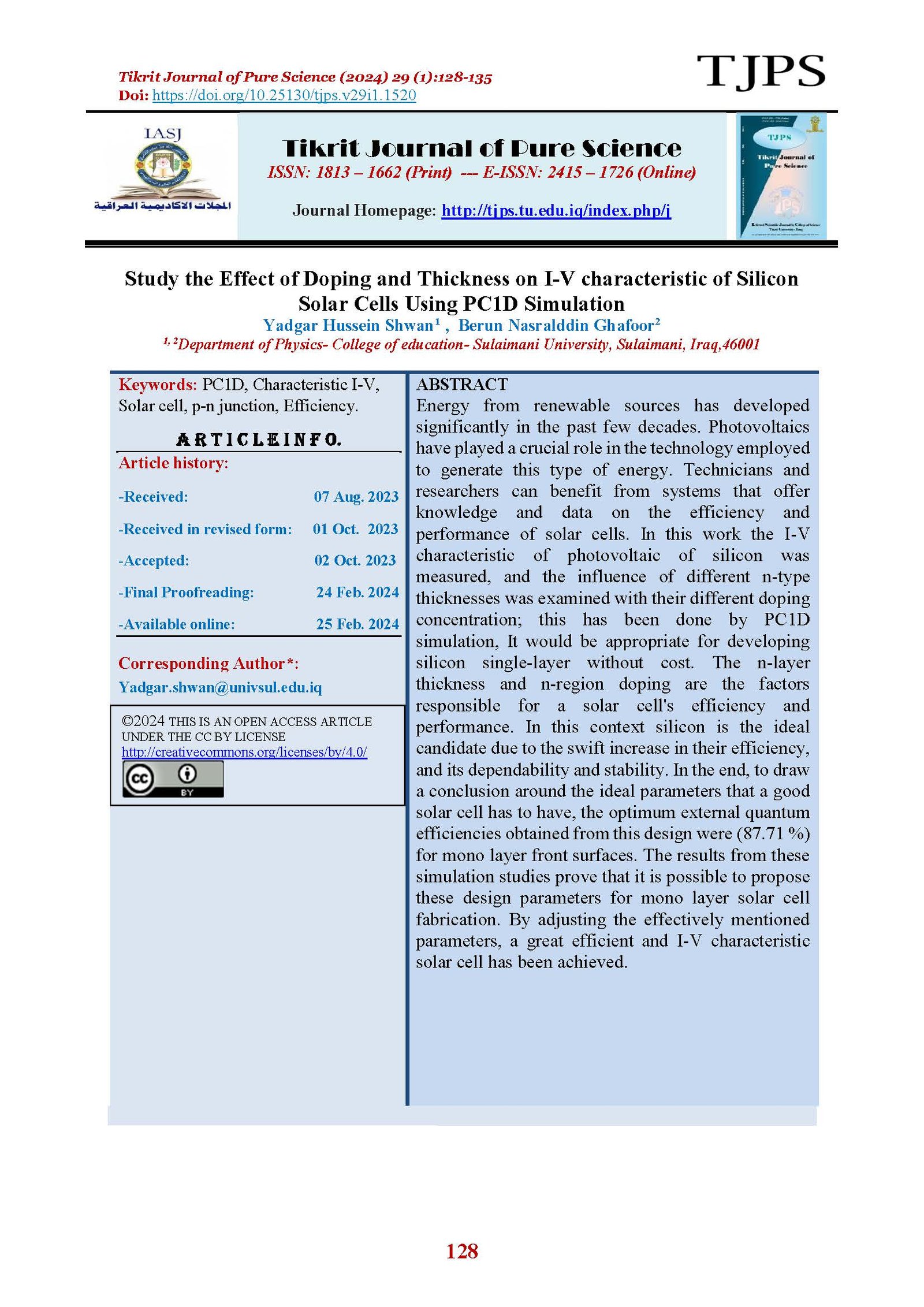Study the Effect of Doping and Thickness on I-V characteristic of Silicon Solar Cells Using PC1D Simulation
Main Article Content
Abstract
Energy from renewable sources has developed significantly in the past few decades. Photovoltaics have played a crucial role in the technology employed to generate this type of energy. Technicians and researchers can benefit from systems that offer knowledge and data on the efficiency and performance of solar cells. In this work the I-V characteristic of photovoltaic of silicon was measured, and the influence of different n-type thicknesses was examined with their different doping concentration; this has been done by PC1D simulation, It would be appropriate for developing silicon single-layer without cost. The n-layer thickness and n-region doping are the factors responsible for a solar cell's efficiency and performance. In this context silicon is the ideal candidate due to the swift increase in their efficiency, and its dependability and stability. In the end, to draw a conclusion around the ideal parameters that a good solar cell has to have, the optimum external quantum efficiencies obtained from this design were (87.71 %) for mono layer front surfaces. The results from these simulation studies prove that it is possible to propose these design parameters for mono layer solar cell fabrication. By adjusting the effectively mentioned parameters, a great efficient and I-V characteristic solar cell has been achieved.
Article Details

This work is licensed under a Creative Commons Attribution 4.0 International License.
Tikrit Journal of Pure Science is licensed under the Creative Commons Attribution 4.0 International License, which allows users to copy, create extracts, abstracts, and new works from the article, alter and revise the article, and make commercial use of the article (including reuse and/or resale of the article by commercial entities), provided the user gives appropriate credit (with a link to the formal publication through the relevant DOI), provides a link to the license, indicates if changes were made, and the licensor is not represented as endorsing the use made of the work. The authors hold the copyright for their published work on the Tikrit J. Pure Sci. website, while Tikrit J. Pure Sci. is responsible for appreciate citation of their work, which is released under CC-BY-4.0, enabling the unrestricted use, distribution, and reproduction of an article in any medium, provided that the original work is properly cited.
References
Salem, M., Zekry, A., Abouelatta, M., Alshammari, M.T., Alanazi, A., Al-Dhlan, K.A., & Shaker, A. (2021). Influence of base doping level on the npn microstructure solar cell performance: A TCAD study. Optical Materials, 121:111501.
[2] Galib, H., M.A.R.A., Basher, M.K., Hoq, M., & Rahman, M.H. (2016). Fabrication of crystalline silicon solar cell in Bangladesh: limitations and remedies. International Journal of Scientific & Engineering Research, 7(5):581-586.
[3] Sahouane, N., & Zerga, A. (2014). Optimization of antireflection multilayer for industrial crystalline silicon solar cells. Energy Procedia, 44:118-125.
[4] Shwan, Y.H. (2022). Calculate The Resonance Angle of Surface Plasmon Resonance Gold film Configured with Kretschmann. Tik. J. of Pure Sci., 27(2):38-42.
[5] Salim, K.D. (2021). Studying the effect of light intensity and the dust on efficiency of Silicon Solar cell. Tikrit Journal of Pure Science, 26(4):68-70.
[6] Mahmood, Y.H., Atallah, F.S., & Youssef, A.F. (2020). Studying the weather condition affecting on solar panel efficiency. Tik. J. of Pure Sci., 25(3):98-102.
[7] Wenham, S.R., & Green, M.A. (1996). Silicon solar cells. Progress in Photovoltaics: Research and Applications, 4(1):3-33.
[8] Belarbi, M., Benyoucef, A., & Benyoucef, B. (2014). Simulation of the solar cells with PC1D, application to cells based on silicon. Advanced Energy: An International Journal (AEIJ), 1(3).
[9] Fell, A., McIntosh, K. R., Altermatt, P. P., Janssen, G. J., Stangl, R., Ho-Baillie, A., ... & Abbott, M.D. (2015). Input parameters for the simulation of silicon solar cells in 2014. IEEE Journal of Photovoltaics, 5(4):1250-1263.
[10] Shwan, Y.H., Berun, N.G., and Govar, H.H. Optimization of Surface Plasmon Resonance (SPR) for Gold/Air Interface by using Kretschmann Configuration. Engineering and Technology Journal, 40(10) (2022):1334-1341.
[11] Nayak, P.K., Mahesh, S., Snaith, H.J., & Cahen, D. (2019). Photovoltaic solar cell technologies: analysing the state of the art. Nature Reviews Materials, 4(4):269-285.
[12] Green, M.A. (2009). The path to 25% silicon solar cell efficiency: History of silicon cell evolution. Progress in photovoltaics: research and applications, 17(3):183-189.
[13] Sepeai, S., Zaidi, S.H., Desa, M., Sulaiman, M., Ludin, N., Ibrahim, M.A., & Sopian, K. (2013). Design optimization of bifacial solar cell by PC1D simulation. parameters, 3(5).
[14] Hashmi, G., Akand, A.R., Hoq, M., & Rahman, H. (2018). Study of the enhancement of the efficiency of the monocrystalline silicon solar cell by optimizing effective parameters using PC1D simulation. Silicon, 10:1653-1660.
[15] Jiang, C., Li, T.Z., Zhang, X., & Hou, L. (2012). Simulation of silicon solar cell using PC1D. Advanced Materials Research, 383:7032-7036.
